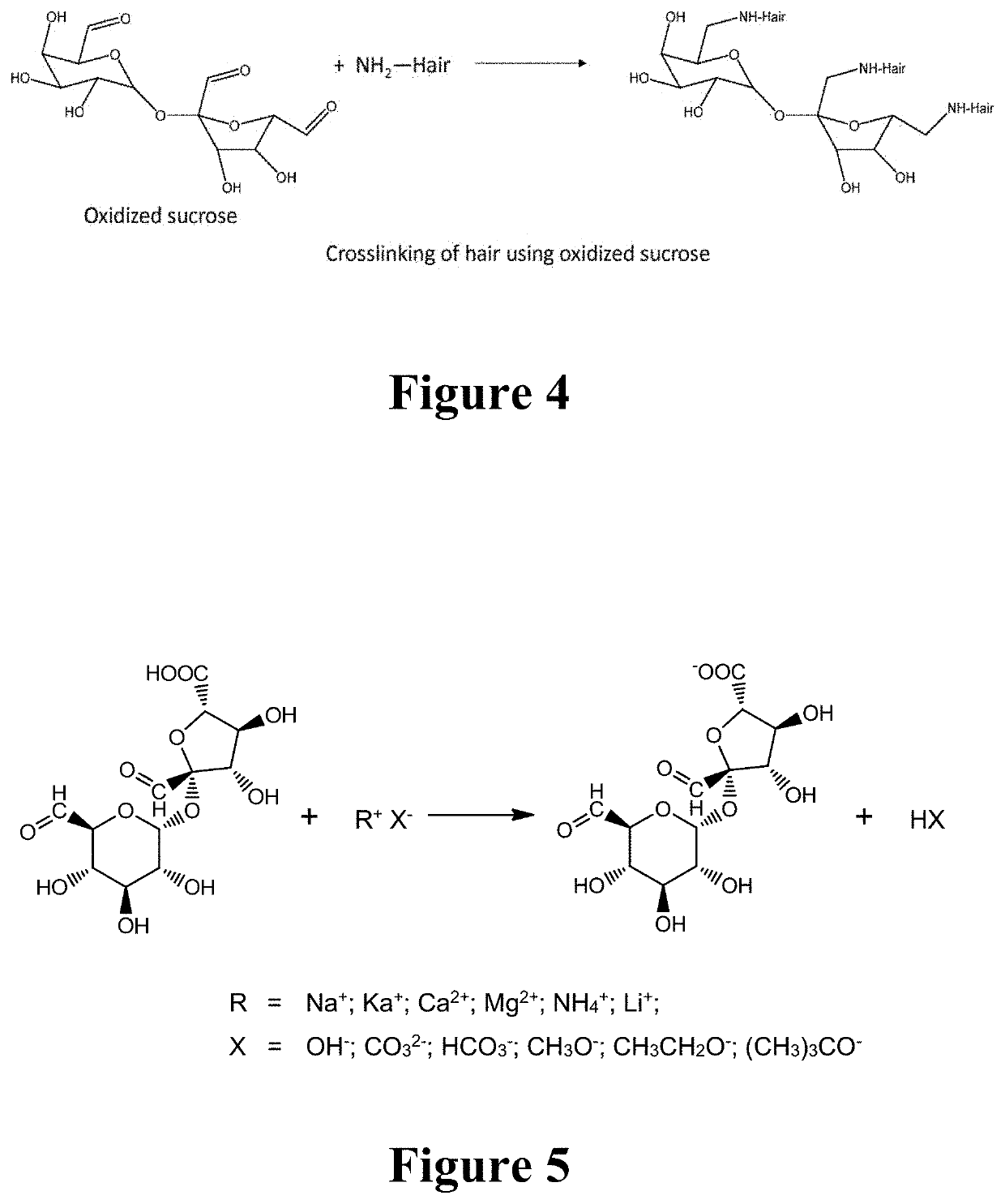Residual soy flour sugars as crosslinkers for enhancing mechanical performance of protein fibers
a technology of protein fibers and soy flour, which is applied in the field of green technology for crosslinking protein molecules, can solve the problems of unfavorable consumer products, unfavorable human health, and easy loss of straightness or curliness, and achieves long-lasting straightness, increased crease retention and stiffness, and improved mechanical performan
- Summary
- Abstract
- Description
- Claims
- Application Information
AI Technical Summary
Benefits of technology
Problems solved by technology
Method used
Image
Examples
example 1
Oxidation of Sugar by Hydrogen Peroxide: The Process
[0163]Twenty (20) g sucrose was added into 150 mL distilled water in a 500-mL flask, stirred for 5 min to completely dissolve the sucrose, then 50 mL of hydrogen peroxide (30%) was added into solution, which made the final hydrogen peroxide concentration to be 7.5%. The oxidation reaction was performed at 60° C. for 12 hrs. These conditions may be varied depending on the needs. The oxidized sucrose was dried in oven at 50° C. for at least 2 days to obtain highly viscous liquid. In order to remove any residual hydrogen peroxide, oxidized sucrose can be re-dissolved and dried one or more times. The chemistry of sucrose oxidation is shown in FIG. 2.
[0164]As mentioned earlier, many sugars (5 carbon, 6 carbon), dimers, trimers, tetramers, etc., including stachyose, raffinose, and many others. It is, however, important to know that higher sugars such as dimers, trimers, tetramers, etc., may even be preferred since they can have more than...
example 2
Aldehyde Group Content Determination
[0166]Two grams of sample was dissolved in 100 mL distilled water in a 500-mL flask. The solution was adjusted to pH 3.2 with 0.5 N NaOH and 15 mL of hydroxylamine reagent was added. The flask was capped (using cork stopper) and placed in a 40° C. water bath for 4 hrs with slow stirring. The excess hydroxylamine was determined by rapidly back titrating the reaction mixture to pH 3.2 with standardized 0.5 N HCl. A blank (without oxidized sucrose) determination with only hydroxylamine reagent was performed in the same manner. The hydroxylamine reagent was prepared by first dissolving 30 g hydroxylamine hydrochloride in 100 mL of 5 N NaOH before the final volume was adjusted to 500 mL with distilled water.
[0167]Carbonyl group content was calculated as follows:
Aldehydecontent(%)=[blank-sample)mL×acidnormality×0.028×100]sampleweighting(drybasis)
[0168]Table 1 presents the sucrose oxidation conditions used and their corresponding aldehyde contents obtain...
example 3
Hair Treatment and Characterization
Crosslinking of Human Hair (and Other Protein Fibers) Using Oven:
[0169]Human hair specimens cut to a length of 10 cm were used in this test. The hair pieces were washed with Tide detergent solution (0.36% concentration) and rinsed with continuous water for 3 min. Eight (8) g of oxidized sucrose was added to 125 mL beaker containing 50 mL of water. Different oxidized sucrose concentrations can be used as long as oxidized sucrose can be well diffused from solution into inner structure of the hair. Higher the amount of oxidized sucrose diffused inside hair, more the crosslinking achieved. This can lead to higher straightness of the hair (when treated with flat-iron) as well as increased retention in humid air. Concentrated sodium hydroxide solution was used to adjust pH to 11, soap washed hair specimens were immersed and stirred at 50° C. with stir speed of 70 rpm for 15 min, 30 min and 1 hr, separately, in 3 trials. Treated specimens were placed on a...
PUM
| Property | Measurement | Unit |
|---|---|---|
| temperature | aaaaa | aaaaa |
| temperature | aaaaa | aaaaa |
| temperature | aaaaa | aaaaa |
Abstract
Description
Claims
Application Information
 Login to View More
Login to View More - R&D
- Intellectual Property
- Life Sciences
- Materials
- Tech Scout
- Unparalleled Data Quality
- Higher Quality Content
- 60% Fewer Hallucinations
Browse by: Latest US Patents, China's latest patents, Technical Efficacy Thesaurus, Application Domain, Technology Topic, Popular Technical Reports.
© 2025 PatSnap. All rights reserved.Legal|Privacy policy|Modern Slavery Act Transparency Statement|Sitemap|About US| Contact US: help@patsnap.com



